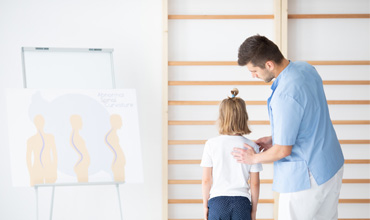Scoliosis affects about 1 in every 40 people according to the National Scoliosis Foundation. The term scoliosis is derived from the ancient Greek word skolios, which means bent or crooked. Scoliosis is a deformity of the spine—instead of being straight, it curves sideways and twists. In most cases, there is no known cause for this condition, and nothing can be done to prevent it. If someone in your family has had scoliosis, your child is at increased risk of developing it.
Scoliosis is More Prevalent in Adolescents
Anyone can be diagnosed with scoliosis—from babies to the elderly. Most of the time, however, it is diagnosed in children between 10 and 15 years old. Girls and boys get scoliosis at about the same rate. Yet girls are eight times more likely than boys to need treatment for a more severe condition. A diagnosis of scoliosis is made when the side-to-side curvature of the spine is more than ten degrees. The more curved the spine is, the more severe the condition.
What are the Signs?
During periods of rapid growth, children can develop scoliosis without parents noticing it. Sometimes a child’s friends or teammates are the first to observe the signs. Watch for the following:
- One shoulder, shoulder blade, ribs or hip is higher than the other side
- One shoulder blade or hip stands out more than the other
- The head isn’t centered on the body
- One side of the ribcage sticks out
- The spine is curved sideways when you look at the child from the back
Early Detection is Critical
A spinal screening takes about 30 seconds. This simple noninvasive assessment may help save a child from a lifetime of problems associated with scoliosis. Deformities that result can impact a child’s self-esteem or limit physical activity. A lifetime of back pain is another side effect. If the curve of the spine is severe, it can reduce the amount of space in the chest. Then the heart and lungs may not be able to function normally. Early treatment can stop the curve from getting worse or help reduce the size of the curve.
Spinal Screening Program in Texas
The Texas Legislature established a Spinal Screening Program to identify students who may have scoliosis so that they can be referred to their healthcare providers for followup. Here is the recommended schedule:
- Girls will be screened two times, once in 5th grade and again in 7th grade
- Boys will be screened one time in the 8th grade
All children must comply with the screening requirement unless parents provide documentation of screening by a licensed professional or a statement of religious conflict.
Screening is done by a certified spinal screener who has received special training, or by a licensed healthcare professional. Children may be asked to pin up long hair. All children must take their shoes off for the screening.
The screener will ask the child to take several different position as they look for spinal abnormalities. A standard exam is the Adam’s Forward Bend Test: bend forward with the knees straight until the back is parallel to the floor; keep the palms of the hands together and hanging down as if diving into a pool.
Students who test positive for abnormal spinal curvature will be rescreened to confirm the findings. If the second screening is positive, the child will be referred to their healthcare provider for follow-up.
How is Scoliosis Treated?
When a child has signs of scoliosis, your provider will order tests, such as x-rays, to confirm a diagnosis. According to the Texas Spinal Screening Program Guidelines, more than 90 percent of students with scoliosis require no treatment other than observation. If the curvature of the spine is mild, the child will be monitored to see if the curve gets worse. If the curve is progressing, bracing can be very effective if the child wears the brace as prescribed. About 30,000 children per year are fitted for a brace. For severe cases, surgery is required.
To learn more about scoliosis, watch Catch the Curve, a YouTube video produced by the National Scoliosis Foundation at https://youtu.be/wQmBIhnHnAE.
Brenda Schoolfield is a medical writer and editor who lives in Austin. Sugar, her cocker spaniel, and sometimes a rescue foster dog or two keep her company while she writes.

















